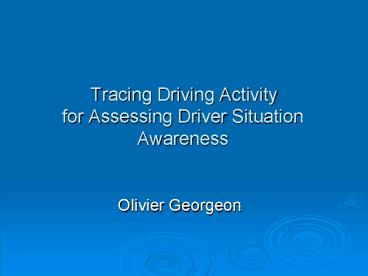Tracing Driving Activity for Assessing Driver Situation Awareness PowerPoint PPT Presentation
1 / 15
Title: Tracing Driving Activity for Assessing Driver Situation Awareness
1
Tracing Driving Activityfor Assessing Driver
Situation Awareness
- Olivier Georgeon
2
Outline
- Introduction
- Theoretical Context
- Knowledge, Representation, Reflexivity
- Software tool
- Next steps
3
Introduction
- Situation Awareness (Endsley, 1995)
- Perception
- Comprehension
- Prevision
- Driver sets up his Situation Awareness by using
both environmental information and long term
memory knowledge. - Part of this outside information can be recorded
during experiment. - Part of the long term memory knowledge can be
made explicit through psychological techniques. - Driver behavior depends on his Situation
Awareness. - Part of the driver behavior can be recorded
during the experimentat. - Can we assess driver Situation Awareness from
data collected throughout the experiment and
from our psychological knowledge? - Can we help the driver to get a better Situation
Awareness?
4
Knowledge and Representation
- Cognition without representation
- Rodney Brooks
- Situated Cognition
- Dreyfus, Suchman, Clancey
- Structural Coupling
- Varela
- Representation
- 1. Etymology Make present again.
- 2. A presentation to the mind in the form of an
idea or image. - Basic Concept of psychology
- Ochanine
- Bisseret
- Minsky
- Jean-Baptiste HAUE
- Beatrice Bailly
- Emmanuelle Boloix
5
Therefore
- We adopt a broad conception of what
Representation is - The driver has knowledge of the current
situation. - This knowledge can be represented
- This representation is not necessarily isomorphic
to a representation of the environment. - Temporal dimension
- Interactive dimension driver / environment
- The driver himself has a representation of his
knowledge that enables him to reason.
6
Software tool
7
Problem
- Recording of environmental data and driver
behavior data gives Giga bytes of barely
understandable data. - How can these data make sense to us? i.e. How to
represent these data in an understandable and
easy to read manner, so they can be exploited? - Can we be inspired by how the driver himself
makes sense of what he perceives from the
environment? - Inversely, if these data make sense to us, will
it be the same meaning as the one given by the
driver? i.e. Will it help us to better
understand the Situation Awareness of the driver?
8
Source data
Source data Strip of "observables" with
properties.
Real driving experimentation
9
Numerical Data
- Threshold Detection
- Local Extrema
- Inflexion points
- Entropy (Boer, 2000)
10
Rough Trace
Source Data
Rough Trace Graph made of a strip of
observables enriched with descriptors.
Easy to read thanks to zoom and edit
functions. Conforms to an Ontology (Collect
Model). Allows us to apply automatic computation
11
Primitive Trace
Primitive Trace Graph structured into states and
transitions
Rough Trace
Easy to read thanks to zoom and edit
functions. Conforms to an Ontology (Use Model).
12
Driving Schemas
Driving Schema
Primitive Trace
Z1
Z2
Z3
Z4
Abstract representation of activity Can describe
driver's mental knowledge Easy to read by a
psychologist or the driver himself Bounded to
schema signatures allowing the expert to find its
instantiation in the primitive trace.
13
Architecture
Driving Experiment
- Video Decoding - Signal Processing
Source Date
- Collect Ontology - Description rules - Symbolic
Tagging
Rough Trace
- Use Ontology - Description rules - Symbolic
tagging
Primitive Trace
- Construction of driving schema - Construction
of schema signatures - Find occurrence of driving
schema
Driving Schema
14
Conclusion
Driving Experimentation
Driving Schemas
- Present the recorded data in a manner that can
make sense to us. - Discover driving schemas.
- Find occurrences of driving Schemas along driving
activity. - Validate our assumptions about Driving Schemas.
15
Next steps
- Use the software tool
- Enrich the ontology.
- Test rules
- Set the limits
- Continue Implementation
- Primitive trace construction.
- Connect to a driving simulator
- Validate the principle by the mean of a driving
experiment.

